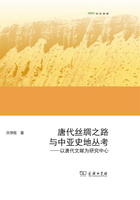
Abstract
From 624 AD up to 727 AD,the states of Central Asia had a direct contact with the Tang Dynasty for as long as 149 years. The Silk Road became a link for the two sides to communicate in political, economical and military affairs. In the history of China, Tang's political power, for the first time, spread farther than Chong-Ling, setting up an indirect dominating system in such lands as Transoxania and Tokharestan. It created a kind of political dependency between Central Asia and Tang. The history of the communication between Tang and Central Asia constitutes a rich history in the Tang Dynasty.
The records of the historical changes of the states of Central Asia in the 7th-8th centuries and their communication with Tang are mainly kept in Da Tang Xi Yu Ji (Records of the Western Lands of the Great Tang Period) (《大唐西域记》), Xin Tang Shu Di Li Zhi (《新唐书·地理志》), Xin Tang Shu Xi Yu Zhuan (《新唐书·西域传》), Ce Fu Yuan Gui (《册府元龟》) and other Tang's literature, which also reflected Tang people's knowledge about the states of Central Asia. This book, having these four books as its leading reference, centralizes on the important topic – "the Tang Dynasty with Central Asia", which probes the changes in the Silk Road during Tang, the location of the states of Central Asia and their construction sites, the political growth of Central Asia in 7th-8th centuries, the development of political relationship between Central Asia and Tang, the political relationship among the states in Central Asia, Tang and Da Shi (Arab), the Tang playing role in the struggle of Central Asia against Arab, how far Tang people knew about Central Asia,and how much belief could be borne in the Tang literature. As far as the research method is concerned, this article tries to verify between the literature of Islamic geography, the archaeological achievements and the Tang literature. It also attempts an analysis of the research work done by other scholars.
This article consists of four chapters. Each chapter has its own focus, concerning one Tang's book. Through an all-round research into the records in the Tang literature, the author finds out that the recorded locations of Qianquan (千泉), Baishui city (白水城), GongYu city (恭御城), Nuchijian city (笯赤建城) and Miguo city (米国都城) couldn't be in correspondence with the records of Islamic literature (Abarjaj, Isfijab, Nujakath, Māymurgh). Tang's people confused Cao (西曹,West Cao) with East Cao (东曹). They didn't quite understand the history of Islamic of Central Asia. There are a 1ot of errors made in Tang's records of the construction sites of the states in Central Asia. Since the late 8th century, with the change of the political circumstances in the east of Western Lands, the trend of the Silk Road in Chinese territory altered. The Chinese and Central Asian didn't follow exactly the same route. The states of Central Asia did not bear a same kind of close relation with Tang. The presentation of tribute of Central Asia paid to Tang is in a political activity rather than a commercial one, reflecting the history of the change in political relationship between Central Asia and Tang. In Central Asia, Tang did back the states of Central Asia in their struggle against Arab. And the relationship between Tang and Arab can't be defined as a good allied one.